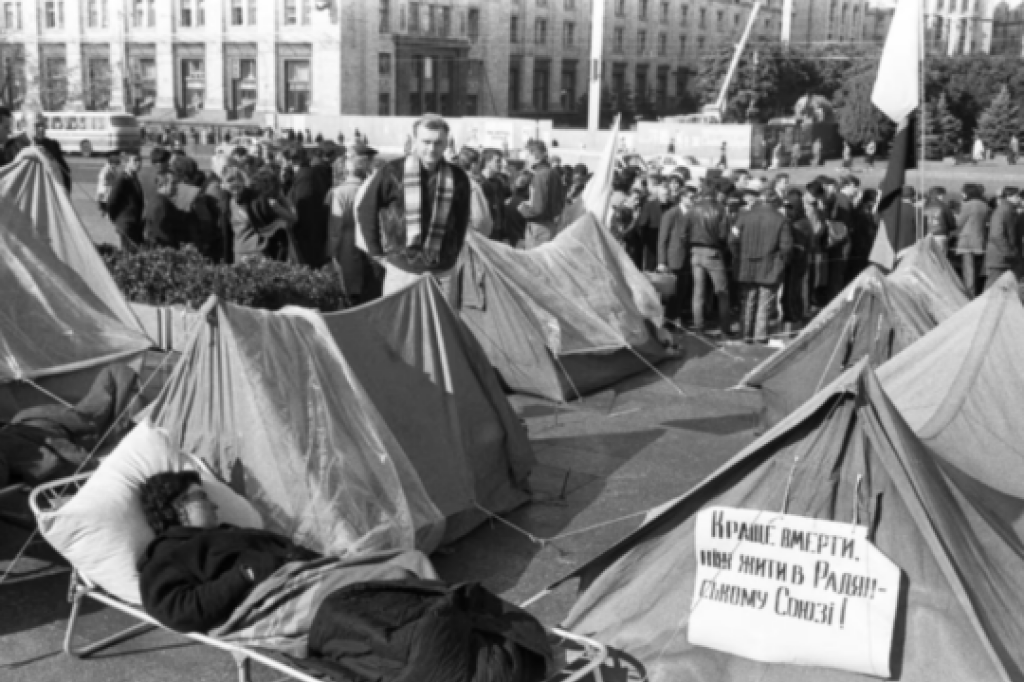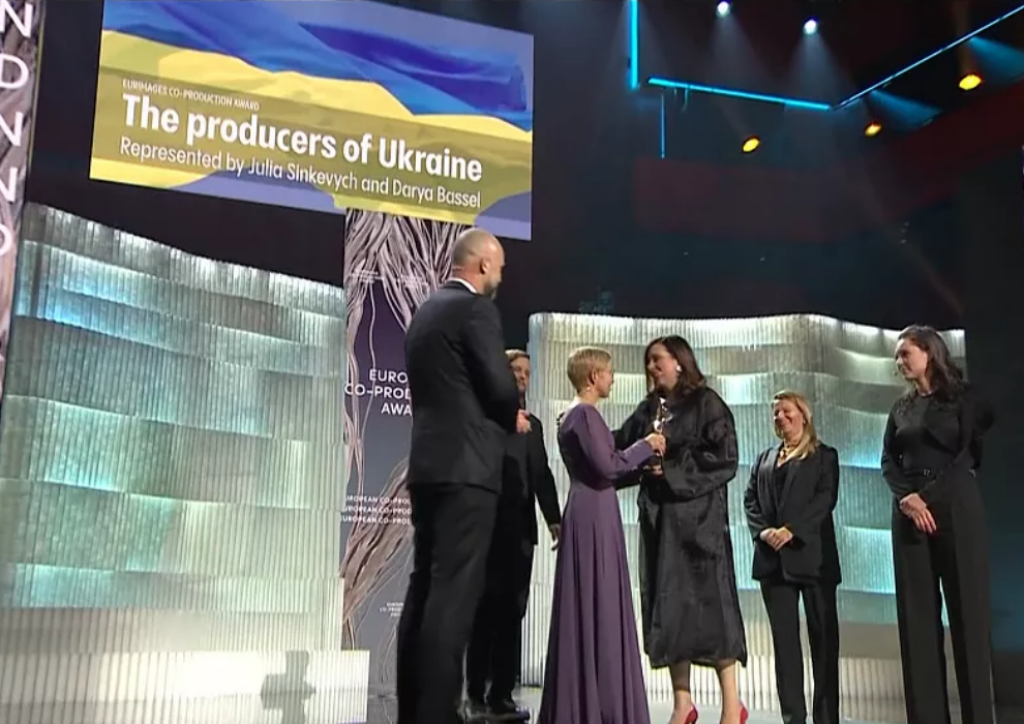Paulina Codogni is Associate Professor in the Department of International Organizations and Global Security Studies in the Institute of Political Studies of the Polish Academy of Science.
Human history is full of actions that attracted the attention of researchers almost as soon as they occurred armed conflicts, civil wars, insurrections, and some nonviolent struggles like Mahatma Gandhi’s Salt March, American antiracist campaigns, or the fall of Berlin Wall. On the other end of the spectrum are under-appreciated events that are assigned a marginal significance or even ignored. Some of these are permanently consigned to oblivion, but others manage to escape it, generating interest years later when new circumstances thrust them into the spotlight
One such struggle, whose significance was discovered and analyzed only two and a half decades later, was the partially successful Revolution on Granite that took place in Kyiv in October 1990. Through their action, its participants sought to exert pressure on the authorities of the Ukrainian Soviet Socialist Republic and force them to accept five clear and precise postulates, including the rejection of a new agreement on the Soviet Union, the New Union Treaty; the resignation of the Chairman of the Council of Ministers of the Ukrainian SSR, Vitaliy Masol, and an end to Ukrainians serving in the army outside of the Republic.
The Revolution on Granite was significant for two reasons. First, it was a major milestone on the road to Ukrainian independence, or even a starting point for aspirations of independence. Second, it became a prototype for subsequent Ukrainian revolutions and a precursor to future events set on the Maidan—first in 2004 and again in 2013-2014.
External factors, most prominently CPSU General Secretary Mikhail Gorbachev’s reforms, were certainly important in causing the Revolution on Granite. Yet the roots of its success lie in internal factors within the independence movement itself.
The main scene of the protest was the Square of the October Revolution in Kyiv, renamed Maidan Nezalezhnosti (Independence Square) in 1990. The event’s name derives from the granite stones covering the square. There, between October 2-17, 1990, a student hunger strike took place. It was initiated by students from Lviv and Kyiv, but already in the first days participants from other students’ centers arrived with support. By the end, the protest had amassed 298 participants. Such a large hunger strike required considerable organization. Besides those directly involved, hundreds of additional students provided logistical support and strike protection. Approximately 100,000 students, a fifth of the total number of students in Ukraine, were engaged in different forms of action related to the hunger strike.
The leaders of the Revolution on Granite proceeded from two strategic assumptions. The first was about the importance of choosing the highest form of self-sacrifice as the primary method of protest. They focused on just one activity—the hunger strike—with any other activities taking on an ancillary function. At the same time, the protest’s leadership made discipline a priority. As a result, during the two weeks of Revolution, there were no acts of violence or vandalism.
On the square itself, there was a visible division between the group on active hunger strike and a supporting group of students responsible for order, logistics and communication. The strikers wore white headbands with the inscription “I am on hunger strike” in Ukrainian. The heads of the remaining protesters were tied with black headbands.
Photos and film recordings testify to the high level of organization of the site. The protest’s main headquarters, along with its press organs and medical services, were located in separate quarters in the middle of the square. Tents for strikers were pitched at equal intervals.
A second crucial point of strategy was to concentrate the protest in just one place, i.e., a tent town on the Square of the October Revolution. This choice of location quickly paid off. A hunger strike conducted in the very center of the city almost immediately attracted the attention of Kyiv residents. Nevertheless, the protest’s methods came as a big surprise to locals, many of whom wanted to support the strikers. Protest participants recall that, on the first day of the strike, people brought food, including home-made cookies. Soon, however, the Kyivans understood the idea of the hunger strike and began bringing blankets, warm clothes and, above all, warm shoes—all items of critical importance for students spending days and nights fastingon cold granite. Apart from supplies and moral support, Kyiv residents visiting the strikers also played a protective role. Their presence made the students feel more confident that security forces would refrain from an attack.
From the strike’s start, protest leaders realized that persuading protesters to maintain their positions and attracting others required making the strike appealing. Common cultural activities like singing, reciting poetry, or putting on specific outfits served to strengthen group identity and imparted a sense of community. From the very first moments of the Revolution on Granite, a specific atmosphere or culture of protest developed in the camp. Famous actors, performers of sung poetry, and rock groups appeared on the square to support hunger strikers with their performances.
After two weeks, the protest had an effect, with the Ukrainian authorities deciding to fulfill at least some of the protesters’ demands. Ukrainians would no longer have to fulfill their military service outside of the Republic. Vitaly Masol agreed to resign. These gains meant symbolic victory over the regime. The realization of the strikers’ other demands may have been postponed, but the authorities could be certain that they would not be forgotten. Moreover, the broader process of achieving Ukrainian independence was already underway, taking place behind closed doors in the offices of the political elites.
The significance of the Revolution on the Granite only became fully visible after many years, when it became possible to juxtapose it with subsequent revolutionary events from 2003 and 2014. It was in October 1990 that, for the first time in Ukraine’s history, a protest group organized and succeeded in seizing a square in the center of the nation’s capital.
Beyond preparing future political events, the Revolution on Granite opened a new chapter in the tradition Ukrainian protest as such. From that moment forward, political actions would take the form of occupying the central square with a tent city filled not only with the protesters themselves, but with artists appearing on a stage to warm up and motivate the crowd. This cultural dimension persisted through subsequent events, including those occurring in 2001, 2004, and 2013-2014.
The words of Viktor Rog, one of the original participants in the Revolution Granite, aptly summarize the event’s significance in comparison with the later Ukrainian revolutions. “I call it the revolution against fear,” he stated. “The Orange Revolution was against lies, whereas the Revolution of Dignity was against humiliation. If we hadn’t fought fear, we couldn’t also fight constant humiliation.”



